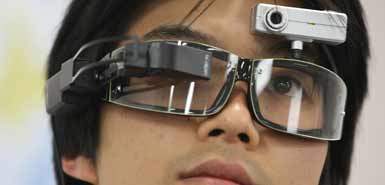You know the feeling. Call it a senior moment, absent-mindedness or a sign of what a busy active brain you have. We’ve all asked ourselves that irritating question: “Where on earth did I leave my car keys?”
Now a team of Japanese scientists claim to have come up with the
 answer. And the secretive artificial intelligence project codenamed Smart Goggle does not stop at elusive keys. With Yasuo Kuniyoshi’s invention balanced on your nose, nothing – be it the remote control, mobile phone or iPod – should ever go missing again.
answer. And the secretive artificial intelligence project codenamed Smart Goggle does not stop at elusive keys. With Yasuo Kuniyoshi’s invention balanced on your nose, nothing – be it the remote control, mobile phone or iPod – should ever go missing again.
Simply tell the glasses what you are looking for and it will play into your eye a video of the last few seconds you saw that item.
Built on to the glasses is a tiny camera which makes a constant record of everything the wearer sees: the tiny display inside the glasses identifies what is being scanned and a small readout instantly announces what the computer thinks the object probably is. For some things that look different from a range of angles, however, the glasses offer only a “best guess” – they are better at identifying a guitar and a chair than a coathanger or battery.
The hardware itself is not extraordinary: what has taken Professor Kuniyoshi several years to perfect is the computer algorithm that allows the goggles to know immediately what they are seeing. It is, he says, a problem that has always vexed the fields of robotics and artificial intelligence.
But working in a team with Tatsuya Harada, one of Japan’s masters of the science of “fuzzy logic”, Mr Kuniyoshi believes he has cracked the problem. Behind the goggles is possibly the world’s most advanced object recognition software and a computer that can learn the identity of new objects within seconds.
So if the user wanders round the house for about an hour telling the goggles the name of everything from that coathanger to the kitchen sink, they will remember. Then if, at some point in the future, you ask them where you last saw a particular item, they will play the appropriate footage.
Professor Kuniyoshi has even greater ambitions for his software, ambitions that owe a lot to the visual display of the Terminator of science fiction. He describes his goggles as the ultimate connection between the real world and the cyber world and believes that they could eventually be loaded with vast quantities of data from the internet.
With that database installed, the glasses might actually know much more about what the wearer is seeing than the wearer himself – species of animal, technical specifications of vehicles and electronics, or even the identity of people. In a demonstration, the professor showed how the user might, for example, gaze at a selection of unknown flowers and the glasses would say which were begonias, which were ferns and which were pansies.
Although the experimental model, shown exclusively to The Times yesterday, is still too bulky for daily use, the team at the Tokyo University School of Information Science and Technology are confident that it can soon be miniaturised. It could even, they suggest, be small enough to look little different from a normal pair of glasses.
But unfortunately, of course, there is one irritating question they would not be able to answer: “Now where did I put my glasses?”
Source : bdnews 2008

